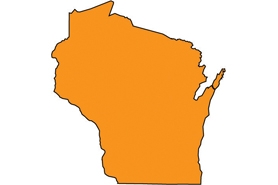Tree of Heaven
(Ailanthus altissima)
Rapidly growing trees that can reach 80’ or more. Tree of Heaven has smooth stems, pale gray bark and light brown twigs. Leaves and male flowers have a strong odor of rotten peanuts.
Other names for this plant include:
- Common names: China sumac, stink tree, ailanthus
- Scientific names: A. glandulosa; Rhus cacodendron
Classification in Wisconsin: Restricted
- Ecological Threat
-
- Aggressive invaders of urban areas, fields, roadsides, fencerows, woodland edges and forest openings. It may occur as seedlings in recently planted fields.
- Prolific seed producers, once established, can form an impenetrable thicket.
- Allelopathic; the plant produces toxic chemicals to other organisms, both plants and insects.
- Identification
-
Leaves: Large, alternate, pinnately compound, 1-4’ long. They are composed of 11-25 entire leaflets except for 1 to several glandular teeth near the base.
Flowers: Small; yellow-green; 5-6 petals; borne in dense clusters near ends of upper branches in late spring; dioecious.
Fruits & seeds: Green turning pink to tan, papery, two-winged samaras in clusters. Develop in late summer to early fall and may remain on the tree through winter.
Roots: Aggressive; spreading rhizomes.
Similar species: Black walnut (Juglans nigra), butternut (Juglans cinerea), and some species of sumac (Rhus spp.). The leaf margins of the look-alikes have tiny teeth, except winged sumac, while those of the tree of heaven is smooth.
- Control
-
Mechanical: Seedlings can be removed by hand. Trees may be cut at ground level with a saw, most effective when the tree has begun to flower. Re-sprouts may occur after treatment and successful control will require repeated cutting.
Chemical: Foliar spray with either glyphosate or triclopyr ester from June-September. Basal bark with triclopyr ester during the summer—cut-stump treatment with triclopyr or glyphosate.
For more information on control techniques, visit the Tree-of-Haven factsheet [exit DNR] by the University of Wisconsin-Extension.
- Resources
- Sources for content:
- Czarapata, Elizabeth; Invasive Plants of the Upper Midwest: an illustrated guide to their identification and control. The University of Wisconsin Press. 2005. Pg. 87-88


